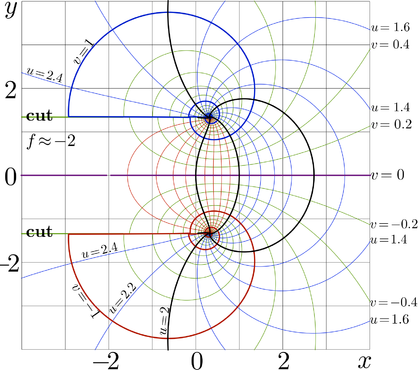Difference between revisions of "ArcTetration"
| Line 1: | Line 1: | ||
| + | <div style="float:right; width:400px"> |
||
| ⚫ | |||
| + | [[File:Ater01.png|420px]] |
||
| ⚫ | |||
| ⚫ | |||
| + | |||
| + | [[File:B271a.png|420px]] |
||
| ⚫ | |||
| + | </div> |
||
[[ArcTetration]] \( \mathrm{ate} \) is inverse function of [[tetration]]; it is [[Abel function]] of the [[exponential]]. |
[[ArcTetration]] \( \mathrm{ate} \) is inverse function of [[tetration]]; it is [[Abel function]] of the [[exponential]]. |
||
Revision as of 22:29, 30 November 2019
 \( \mathrm{ate}_b(x) \) versus \( x \) for various \(b\)
\( \mathrm{ate}_b(x) \) versus \( x \) for various \(b\)
 Complex map of ArcTetration: \( u\!+ \!\mathrm i v \!=\! \mathrm{ate}(x\!+\!\mathrm i y)~\) for base \( b\!=\!\mathrm e \)
Complex map of ArcTetration: \( u\!+ \!\mathrm i v \!=\! \mathrm{ate}(x\!+\!\mathrm i y)~\) for base \( b\!=\!\mathrm e \)
ArcTetration \( \mathrm{ate} \) is inverse function of tetration; it is Abel function of the exponential.
Basic properties of ArcTetration
For real values of the argument, \( \mathrm{ate}_b(x) \) is plotted versus \( x \) at various valies of \( b\!>\!1 \). Being the inverse function of tetration, the ArcTetration \( \mathrm {ate}_b \) to base \( b \) satisfies the relations
- \( \mathrm{ate}_b(\mathrm{tet}_b(z))=z \)
- \( \mathrm{tet}_b(\mathrm{ate}_b(z))=z \)
at least in some ranges of values of \( z \).
The ArcTetration satisfies the Abel equation
- \( \mathrm{ate}_b(b^z)=\mathrm{ate}_b(z) +1 \)
for the exponential as the transfer function. In this sense, ArcTetration is an Abel function of the exponential. Roughly, the arctetration counts, how many times the logarithm should be taken of a value before the value becomes unity.
For base \( b\!=\!\mathrm e \!\approx\! 2.71 \), the natural ArcTetration is presented in figure at right with the complex map. For \( f\!=\!\mathrm{ate}(x+\mathrm i y) \), the isolines \( u\!=\!\Re(f) \) and \( v\!=\!\Im(f) \) are drawn in the \(x \), \(y \) plane.
Terminology and cuts
In some publications, the term super-logarithm is used instead of ArcTetration.
Such a notation may cause confusion, because ArcTetration is not a superfunction of logarithm. For this reason, in TORI the name ArcTetration is used.
According to the definition of Abel function, ArcTetration is Abel function of the exponential. However, the additional requirement that \( \mathrm{tet}_b(\mathrm{ate}_b(z))\!=\!z~\) at least in some vicinity of the real axis specifies that
- \(\mathrm{ate}_b(1)=0\)
and determines its asymptotic properties; in particular, its behavior in vicinity of the fixed points of the exponential, which are the branch points of \( \mathrm{ate}_b \). The cut line(s) for ArcTetrational are chosen to be "horisontal" (assuming that the complex plane at the screen is vertical), they go from a fixed point of exponential to the left, to the negative values of the real part of the argument, keeping the imaginary part. In particular, for \( 1\!<\!b\!<\!\exp(1/\mathrm e) \), the fixed points of \( \exp_b \) are real, and the ArcTetration \( \mathrm{ate}_b \) has the only one cut line, that goes to \( -\infty \) along the real axis.
Uniqueness of ArcTetration
The requirement on the behavior of ArcTetration as the argument approaches the fixed points of the corresponding exponential provide the uniqueness of this function.
For \( b\!>\!\exp(1/\mathrm e) \), the conditions of the uniqueness are determined by the requirement of bi-holomorphism in certain range that extends from one fixed point of the exponential to another fixed point [1].
Numerical evaluation
For real base \( b\!>\!1 \), the ArcTetration can be evaluated with numerical inversion of tetration. For \( b=\mathrm e\), which refers to the "natural tetration", the 14-digit complex(double) C++ implementation is available [2].
Application
Together with tetration $\mathrm{tet}$, the ArcTetration determines the fractional iteration of the exponential. The $c$th iteration of $\exp_b$ is defined as follows:
- \( {\exp_b}^c = \mathrm {tet}_b( c + \mathrm{ate}_b(z)) \)
At \( 0\!<\!c\!<\!1 \), such a function may be useful for description of processes that grow faster than any polynomial but slower than any exponential. Such functions greatly extend the ability of holomorphic fitting of dependences with non-trivial (or just unknown) asymptotic behavior.
Also, the ArcTetration can be used for the numerical representation of huge numbers, that cannot be stored in the conventional floating-point form (mantissa, logarithm). Instead of to store a huge number \( N\), one may store just \(\mathrm{ate}(N)\). Due to the fast growth of tetration, such a representation is not precise at all, but it greatly extends the range of real numbers that are still distinguishable from infinity. However, the arithmetical functions should be implemented in such a way, that no conversion of the number into the conventional (floating point) form is required at the intermediate steps.
Up to year 2011, no commercial application of ArcTetration have been reported.
Keywords
tetration, Abel function, Abel equation, Transfer equation, Transfer function
References
- ↑
http://www.springerlink.com/content/u7327836m2850246/
http://mizugadro.mydns.jp/PAPERS/2011uniabel.pdf H.Trappmann, D.Kouznetsov. Uniqueness of Analytic Abel Functions in Absence of a Real Fixed Point. Aequationes Mathematicae, v.81, p.65-76 (2011) - ↑ http://mizugadro.mydns.jp/PAPERS/2010vladie.pdf D.Kouznetsov. Superexponential as special function. Vladikavkaz Mathematical Journal, 2010, v.12, issue 2, p.31-45.